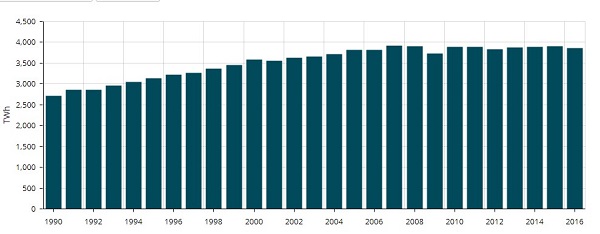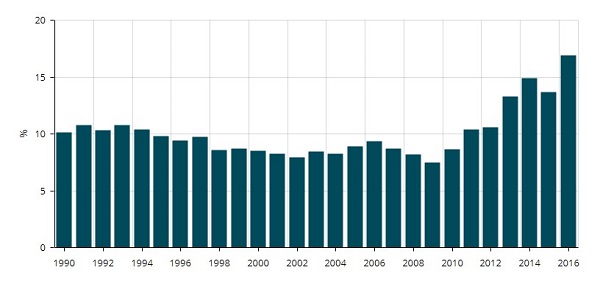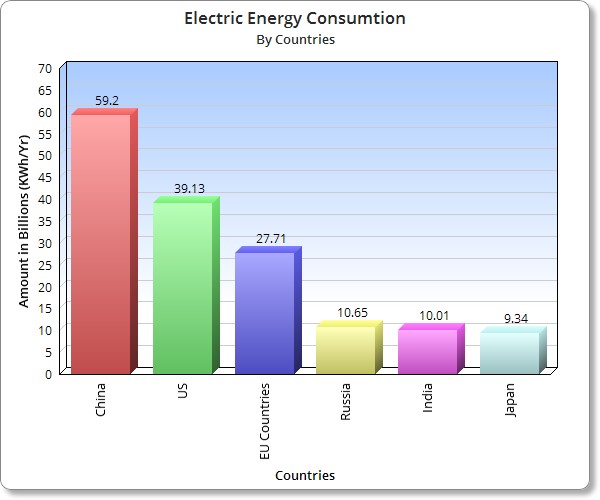Did you know?
More than 45% of total energy consumption takes place because of overall commercial and industrial usage in the world. Only 9.57% of energy originates from renewable sources, which means the rest of the energy consumed is generated by either coal, natural gas or fossil fuels.
Efficient usage of energy has been a critical issue ever since the technology has evolved, especially as it was mentioned on numerous occasions in the World Climate Conference, a significant portion of world leaders and governments have raised their concerns about the decaying level of non-renewable energy source left on the planet earth.
On the other hand, results of Rapid glassier melting, leading to sea level rise throughout the world and severe greenhouse factors are already visible in the occurrences of frequent natural disasters over last 5-6 years' statistics.
Having disastrous condition of weather and simultaneously an acute shortage of resources could be the worst possible context the living world can ever imagine. In this situation, the disaster done to the climate cannot reverted or outdone. The best possible alternative is to decrease the level of energy dissipation due to fossil fuel and non-renewable sources, throughout the world.
The world leaders have eventually agreed to the point of energy efficiency and advised to take necessary steps to work together on the specific fact of concern. Many developed and developing countries have started to apply energy efficiency as shapes of attractive features of energy schemes and incentives.
Firstly, let us have a look at some statistics of the overall electric energy consumption rate by some countries all over the world.
The above graph depicts the amount of electric energy consumed by countries throughout the year. It is clear from the graph that, China holds the highest consumption rate of electric energy with 59.2 billion kWh per year. Whereas, the USA consumes 39.13 billion kWh per year. We already know the fact that, in the USA, China and the other countries which the graph mentions, commercial and industrial sectors and infrastructures consume the most energy.
For example, according to a survey on 2016, 40% of electricity produced is consumed by either commercial or industrial purpose in the USA. Almost similar statistics can be presented for the other topmost electric energy consumer countries illustrated on the graph.
There are countries which are rated significantly low for electric usage. Australia can be mentioned here because of its notable energy efficiency implementation over the time. Government Subsidies vs. Commercial and Industrial Usage: We have already signified the issue of government subsidies or added features, rebates and offers are because of implementation of energy efficiency, which was being acceded during the world climate conferences time and again.
What are these subsidies? Let's take a quick look, why they are critical for countries who implemented these. Government subsidies for energy efficiency are attractive features and rebates, which are discounted, enforced or presented to a specific group or generally, for changing or renovating the existing electricity consumption structure. On existing business structures around the world, energy efficient attributes are not being used promptly for certain rational reasons. One can refute the fact that, the idea of applying regulation on the energy supply has been evolved only since last decade.
Logically, commercial and industrial sectors have the appropriate license for the existing electric products and tools. To promote energy-efficient structures for businesses, the governments have to plan minimum incentives, keeping the business benefits in mind.
So, government subsidies are those minimum incentives, in which commercial and industrial businesses will be interested in implementing. Now let's see the various effects of government subsidies in overall electric energy consumption.
Here we are using two examples, one highly ranked electricity consuming countries and one low electricity consuming country.
USA
The US government provides a wide range of developments and programs for the businesses which initialize energy efficiency. At times, the authority also offers subsidies to energy producers for utilizing efficient machine and tools for production and distribution process. These incentives include tax breaks, exemptions, deduction to the business owners who assure power availability using energy regulation. There are both state and federal government based incentives to raise the point more effectively.
For example, on 2014, a program called OLA (Outdoor lighting accelerator) which provided lighting assistance to government agencies and local municipalities in order to implement sustainable and energy efficient street lighting.
Preference was to use LED lights in place of high power consuming fluorescent lighting fixture.
Likewise, in Alabama, offers 0% interest energy loan for the institutions which are to be paid by the savings of the energy efficiency implementations.
Moreover, Vermont's local government offers a special Commercial lighting and LED lighting program for commercial lighting renovation. It generally rebates up to 250$ for such upgrades. Almost 20 US local/state governments have energy efficiency incentive programs which include the promoting of LED lighting.
 |
|
(Source: Yearbook.enerdata.net)
|
Here we are presenting the electric usage in the US over 1990-2016. It can be understood that the use of power has reduced and come to a stable shape since the rebates and energy efficiency concerns have introduced.
Though, being the highest electricity consumer, the US has been successful in keeping the electricity usage of 2016 less than the amount on 2015. It means, being one of the highest electricity user, US commercial and industrial energy saving incentives have able to keep the minimum usage using efficient alternatives.
Australia
According to global data, Australia is one of the less energy consuming countries in the world. Having total electric energy consumption of 22.4 billion kWh per year, Australia has a significant range of 16.2% units implemented using renewable energy, which is an excellent data for a country which is promoting energy efficiency.
 |
|
(Source: Yearbook.enerdata.net) |
The reason behind acquiring this significant milestone is sort of elementary comparing the higher ranked countries in terms of energy. According to the surveys on different incentives provided by the local and central government of Australia, rebates seem to be more effective for implementing for commercial purposes.
If we have a look at the state incentives for energy efficiency, we can see that every state in Australia has separate energy-saving incentives which are unique from each other.
VEEC (Victoria Energy Efficiency Certificate) is one such incentive where each certificate denotes one tons of less green gas emission. Here, the Victorian local government has targeted 5.4 million certificates under VEET (Victorian Energy Efficiency Target) scheme.
VEEC rebate scheme in lighting are suggested to be implemented on renovations by the commercial auditors. The products must go through a level of assessment, by which VEEC creates overall awareness on using energy-efficient products.
ESS (Energy Saving Schemes) for New South Wales, SA REES for South Australia can be excellent examples of more decentralized energy efficiency adoption programs.
Why government subsidies are the catalyst of business renovation
From the ideas shared above, it can be easily comprehended that business renovation or upgrade largely depend on how effective government rebates are. Predominantly, it is a mutually beneficial action where the monetary balance should be on the business owner's facet.
Now, a dispute might arise that what the mutual benefits might be. If a business owner renovates his business according to the rebate programs, he will be gaining notable monetary discounts/rebates which reduces his lighting renovation expenditure, as well as a long-term reduction in expenditure that the use of cheaper alternatives like LED lights ensures. As far as government's benefit, we have already looked at the amount of consumption reduced for both the countries after implementation of the rebates and incentives.
That's why it's elementary to say that overall commercial and industrial electricity consumption can be reduced if the government rebates and incentives are effective and profitable enough for the businesses that are looking for positive effects of energy efficient structures.
Author Bio:
Ryan Aslatt, a content strategist, freelance writer and an independent blogger. He mostly writes on LED Lighting, Sustainable Lighting Solution and Eco Friendly Energy alternatives. As a content marketing consultant with over 2 years of experience, he is used to writing well-researched articles that readers will find insightful, engaging and highly readable.














